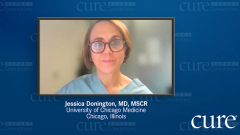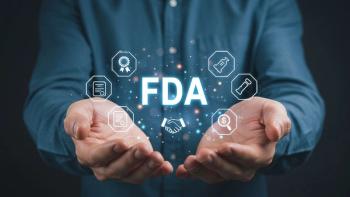
Future Perspectives in Adjuvant Therapy for Early Non-Small Cell Lung Cancer Therapy
Two experts explain how early-stage non-small cell lung cancer treatment has changed in recent years, particularly in the adjuvant setting, and offer future perspectives in this space.
Episodes in this series

Martin Dietrich, M.D., Ph.D.: There are a number of the things that we’re doing to intensify treatment. I do agree, I have a very interesting thought of one of my colleagues here in Florida that says, “I can give you the wrong therapy today or the right therapy next week.” And I would strongly recommend that you seek patience as a guidance tool here. This has gotten so refined that it’s no longer reasonable to accelerate treatment for getting the tumor out quickly. Because it’s not only removing the tumor and being cancer free, but it is the right sequence of events that will get you there in the long run. A second big push that we have been looking at is not how can we double down therapy, but are there patients, or can we identify patients that don’t have that microscopic spread component and then we can avoid treatment. And we use what we call molecular residual disease testing, or MRD, as a tool of great interest to risk stratify patients and that can maybe be able to be cured with surgery alone. And what they’re doing is they’re looking at the primary tumor and sequencing the tumor for basically a molecular fingerprint, similar like you would do a paternity testing. And then they’re looking for essentially DNA waste product in the bloodstream that would be coming from anywhere in the body where a cancer may have gone to after resection and see are there similarities between those two mutation sets. And if there are, that is highly suggestive of persistent disease, even though we can’t see it with the conventional studies of imaging that we have. If a patient has positive residual disease on these tests, the likelihood of disease recurrence is exceedingly high. It’s an additional confirmatory piece to give adjuvant therapy. But we are having great interest in those patients that don’t have molecular residual disease that they certainly would classify as an area of interest for lower risk disease, where we are able to think of de-escalation. This might be very interesting. Again, the sequence of events may change, maybe seeing chemotherapy, immunotherapy upfront, and even targeted therapy upfront of surgery. Having all that information the earlier, the better is a reasonable thing. Sometimes patients ask me, when we’re doing a lot of clinical trials at my institution, why do I need a biopsy when the tumor comes out anyway? And the answer is because it is not one-size-fits-all. I will have tumors where they’re difficult to resect when they may be sitting very close to the central airway, and we are risking a larger surgery than necessary. Maybe even the loss of one lung. There may be already options for size reductions upfront, and that we can utilize that will make it easier for the surgeon to receive a clean field, to basically have a margin free of cancer. And those are all things that are, I want to say like a game of chess, where you have to build on step by step. And you must have a team masterminding these individual steps to have the best possible outcome. Sometimes things may seem counterintuitive, but they have a real true rationale underlining it. And I can tell you, everything that you’re seeing and that we’re talking about is that there’s a tremendous amount of progress. Lung cancer from 15 years ago is no longer recognizable to what we’re doing now, not in any step of the way. And I can assure you that in just 5 years from now lung cancer will look even more refined with even better outcomes. And hopefully we’ll be able to tackle this in all stages, from making cancer more preventable by smoking reduction, by ensuring cleaner air. We’ve seen a lot of lung cancer in nonsmokers. It’s not only a smoker disease. Improving surgery, improving the chemotherapy, immunotherapy and targeted therapy approaches. And then also simplifying and making surveillance more sensitive. Those are all steps that will happen in the next couple of years as the data comes in. We’re working very hard on it. One of the things that is big in lung cancer is now hope. Lung cancer used to be a hopeless disease. I do want to add one additional piece of data, and this is something that was presented last year at the ESMO [European Society for Medical Oncology] meeting by Roy Herbst from Yale, New Haven, Connecticut [Roy S. Herbst, MD, PhD]. Where we looked at the first long-term readout, the first five-year readout of immunotherapy in a trial called KEYNOTE-024, and we saw that about 30% of patients are living five years with stage 4 lung cancer. It used to be that one-year survivor was a long-term survivor. Now you’re seeing five years and that patient population, that tail of the curve is flat. There’s a hope and that those patients are cured from their lung cancer. The stigma of lung cancer is one thing, and the statistics don’t reflect it because remember the statistics of today reflect our treatment from 2016. But I can assure you that the treatment of 2020 will make the statistics of 2026 appear much better. Those are my last thoughts before I hand it back to Dr. Donington for our final closure here.
Jessica Donington, M.D., M.S.C.R.: I absolutely agree with everything you just said. When I first started treating lung cancer in the early 2000s, we were doing everything almost exactly as we were in the 1980s, and it was kind of depressing. And in 2021, I do feel like we are in the middle of a revolution and everything about lung cancer is changing, and I don’t see any of it stopping. We are going to cure this disease to a much better extent than we do now. But a lot of that involves very personalized treatment and maybe it seems like more treatment for some patients, but that is the goal. And some of what we do today was unimaginable 10 years ago. And it is a very exciting time to be a lung cancer doctor and I hope that with more patients surviving that some of the stigma related to this disease goes away. Because we all know that no one asks for this disease and that anybody with lungs can get lung cancer. Thank you once again, Dr. Dietrich for your insightful discussion. And to our viewing audience, thank you so much for joining us. We hope that you found your Cure Connections® discussion to be useful and valuable to the treatment of your patients with early-stage lung cancer and for lung cancer patients and caregivers who have joined us this evening.
Transcript edited for clarity.






